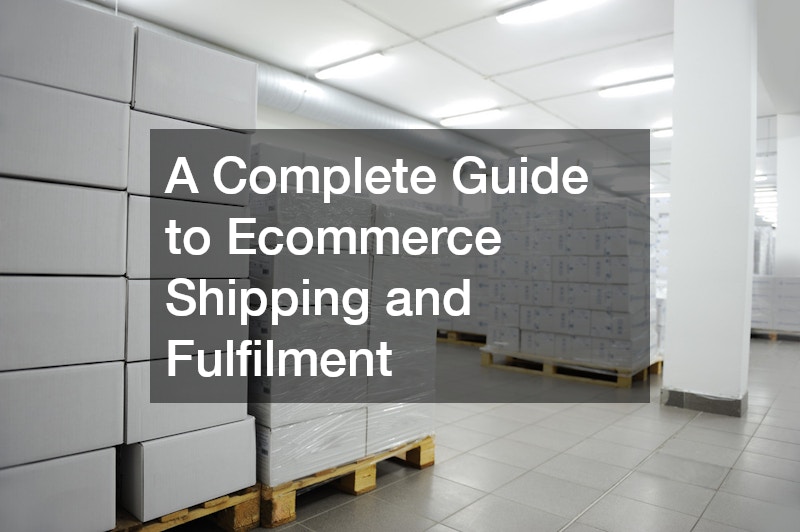Ecommerce has revolutionized the way people shop, offering convenience, variety, and accessibility at the click of a button. However, for online retailers, success isn’t just about creating a beautiful website or offering great products; the backbone of ecommerce lies in logistics, specifically in shipping and fulfilment. Getting products from your warehouse into the hands of customers quickly and efficiently can make or break your business. This guide will walk you through everything you need to know to build a successful ecommerce shipping and fulfilment strategy.
The Importance of a Solid Shipping Strategy
Shipping plays a crucial role in customer satisfaction and retention. A smooth delivery process can make your customers feel confident about their purchase, while delays or high shipping costs can lead to abandoned carts and negative reviews.
In a world dominated by giants like Amazon Prime, where fast and free shipping is the norm, customers have developed high expectations.
Here are the key aspects to consider when developing your ecommerce shipping strategy:
1. Understanding Shipping Rates
The first decision you need to make is how much to charge for shipping. There are several approaches you can take:
– Free shipping: You can offer free shipping by absorbing the shipping costs into your product pricing. This strategy can entice customers to make a purchase, but you need to ensure that it doesn’t eat too much into your profit margins.
– Flat rate shipping: Offering a flat rate for shipping (e.g., $5 per order) simplifies the process for customers and can help cover your shipping expenses.
– Real-time carrier rates: By using an app or plugin, you can calculate and display the actual shipping rates charged by carriers (such as UPS, FedEx, or DHL) at checkout. This method ensures that you don’t undercharge or overcharge customers for shipping.
Each of these strategies has its pros and cons, but the goal is to find a balance between maintaining profitability and meeting customer expectations.
2. Packaging Considerations
How you package your products can influence your shipping rates, branding, and the overall customer experience. The dimensions and weight of your package will directly affect shipping costs. Therefore, optimizing your packaging is essential.
– Lightweight materials: Use lightweight materials to reduce shipping costs. However, don’t sacrifice the protection of your product. Damaged goods will cost you more in returns and lost customers.
– Branded packaging: Consider using branded boxes, tissue paper, or personalized notes to elevate the unboxing experience. The way your product is presented can leave a lasting impression on your customer.
3. Choosing Shipping Carriers
Once you’ve figured out your packaging, the next step is selecting shipping carriers. You can choose from major carriers like FedEx, UPS, DHL, or regional carriers that may offer competitive rates for local deliveries.
You can also consider using fulfilment apps or shipping software that integrate with your ecommerce platform to automatically compare shipping rates, print labels, and even schedule pickups. This automation can save time and help streamline your fulfilment process.
Fulfilment Options for Ecommerce
Shipping is only half the battle in ecommerce logistics. The other half is fulfilment — managing inventory, picking, packing, and ensuring products are ready for shipment. As your business grows, handling fulfilment on your own may become overwhelming. Fortunately, there are several options available:
1. In-House Fulfilment
If you’re just starting or running a small operation, in-house fulfilment may be the most cost-effective option. You store the inventory, handle packing, and ship items yourself. This method gives you complete control over the customer experience, but as your order volume increases, managing fulfilment internally can become challenging.
2. Third-Party Logistics (3PL) Providers
Third-party logistics (3PL) providers offer a hands-off approach to fulfilment. You store your inventory at their warehouse, and they manage the picking, packing, and shipping of your products. 3PL services can help scale your operations and improve efficiency, especially if you’re shipping internationally. The trade-off is higher costs and less control over packaging and branding.
3. Micro Fulfillment Services
As ecommerce evolves, micro fulfilment services have emerged as an innovative solution. These services involve using smaller, localized fulfilment centers situated closer to the customer. By decentralizing fulfilment, businesses can offer faster delivery times and lower shipping costs. Micro fulfilment services are particularly useful for same-day or next-day deliveries, allowing even smaller ecommerce businesses to compete with giants like Amazon.
4. Dropshipping
Dropshipping is a low-cost fulfilment option where you don’t need to keep inventory. When a customer places an order, you forward it to the supplier, who then ships the product directly to the customer. While this model eliminates the need for warehousing and shipping management, it comes with risks like lower margins, potential stock issues, and less control over the shipping experience.
Best Practices for Efficient Fulfilment
To ensure a seamless shipping and fulfilment process, consider the following best practices:
1. Automate Your Fulfilment Process
Use ecommerce platforms like Shopify, WooCommerce, or BigCommerce that offer built-in fulfilment features or integrate with apps for shipping and inventory management. Automation reduces manual errors and speeds up the order processing time.
2. Track Your Inventory
Accurate inventory tracking is essential for avoiding stockouts and backorders. Use an inventory management system to stay on top of your stock levels and avoid disappointing customers with unavailable products.
3. Provide Order Tracking
Offering customers the ability to track their orders enhances their shopping experience. Most carriers provide tracking services, and integrating this feature on your website gives customers peace of mind.
4. Test Your Shipping Process
Before launching your store or a new product, test your shipping process. Ship trial packages to friends or yourself to ensure your system runs smoothly and costs are properly calculated.
Conclusion
Shipping and fulfilment are the backbone of a successful ecommerce business. A strategic approach to these processes can enhance customer satisfaction, optimize costs, and ensure scalability. Whether you choose in-house fulfilment, partner with a 3PL, or use innovative solutions like micro fulfilment services, finding the right balance between speed, cost, and customer experience is crucial to staying competitive in the ecommerce world.
.



